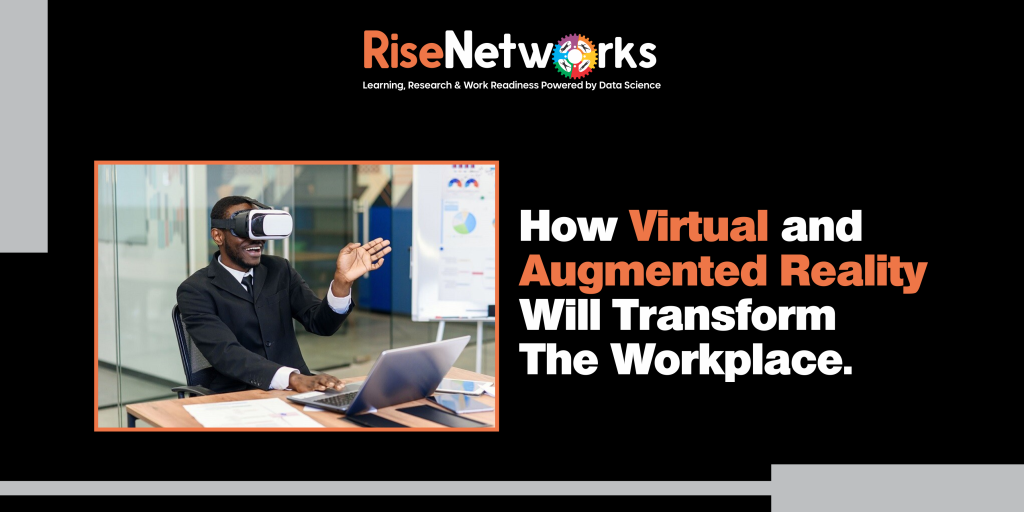Virtual reality, augmented reality, and other technological advances are beginning to change the workplace in many ways.
These technologies will not only transform the world of work, but also the physical spaces in which we operate.
The future of work is here, with Virtual Reality and Augmented Reality poised to change how we present performance and run meetings altogether.
Virtual reality (VR) and augmented reality (AR) are making big waves in the tech world, as well as many other industries,
When you think of virtual or augmented reality, you might think of popular video games like Pokemon Go or World of Warcraft.
However, VR and AR are becoming more common in the workplace. This technology is changing the way workers communicate, train, collaborate and learn.
What is Virtual & Augmented Reality
Virtual Reality
Virtual reality is a computer-generated simulation of a three-dimensional image or environment that can be interacted with in a seemingly real or physical way by a person using special electronic equipment, such as a helmet with a screen inside or gloves fitted with sensors.
In a nutshell, VR is a simulated experience similar to or completely different from the real world.
Virtual reality allows users to step into a computer-generated 3D world where they explore their surroundings as if they were there. The user typically wears an electronic head-mounted display that allows them to see graphics and images in 360 degrees.
Augmented Reality
AR is a digitally enhanced version of reality that is formed by using technology to overlay digital information on a picture of something being viewed through a device (such as a smartphone camera); the resulting visual is augmented by computer-generated sound, video, graphics, or GPS data.
Unlike VR, AR doesn’t transport users away from the real world. Instead, it enhances what they see around them by adding computer-generated graphics to real-world objects. For example, Google Glasses allow users to receive information about the people around them. They can also see special deals at nearby stores or get directions to places they need to go.
Virtual reality (VR) and augmented reality (AR) are two technologies that have the potential to significantly transform how we interact with our surroundings. While virtual reality (VR) is used to create digital settings, augmented reality (AR) allows digital content to be projected onto the actual world.
These technologies are already beginning to make their way into everyday life, making their way into consumer marketplaces with games like Pokémon Go and apps that allow users to see how furniture would look in their living rooms before buying it.
However, these technologies are already beginning to be used in workplaces also allowing workers to use them for training purposes, collaboration, and other tasks.
Here are ways VR and AR is Changing The Workplace
Training
Both AR and VR offer new opportunities for training employees in a safe and interactive environment. As virtual reality becomes more affordable, more companies will likely incorporate it into their training programs.
Visualizing data
AR and VR make it easier for people to visualize, analyze and share data, for example, when working with 3-D models of buildings, industrial equipment or consumer products, being able to see those items inside a virtual space is much more useful than looking at traditional blueprints or 2-D renderings.
Collaboration
With AR and VR, work teams can collaborate from anywhere in the world in real-time. This has several benefits in terms of productivity and efficiency because it enables employees to share information and make decisions together quickly — without needing to schedule a meeting or travel to one location.
Design and creativity
AR and VR present tremendous opportunities for designers across multiple industries. AR and VR allow Designs and creativity to be more efficient.
Recruiting And Hiring
Imagine being able to put a job candidate in a virtual environment where they can demonstrate their skills in a safe, low-stress setting.
VR could make it possible for people to practice interviews or other high-pressure situations before the actual event. Imagine candidates being asked a tough question during a mock interview, then rewinding and trying another answer.
Increase collaboration between remote workers
AR and VR provide organizations with new opportunities to connect remote workers across the world.
This can lead to increased employee engagement and collaboration among team members who might never get a chance to meet in person.
Improve customer satisfaction with contact centres
Some contact centres have begun to use virtual reality (VR) to train personnel on how to engage with consumers by immersing them in real-world scenarios with simulated customers.
Less travel
AR and VR allow us to work with people in other places without having to travel to see them.
Improved communication
With features like telepresence (where you appear as an avatar in a virtual meeting), you can make eye contact with others in meetings. And by combining multiple avatars into a single virtual space, you can talk face-to-face, even if everyone is working remotely.
Simulations
These allow employees to practice simulations of equipment before they use it on the job, which is particularly useful for complex machinery or dangerous situations.
New interactions with data
With AR glasses, users can access data through voice commands (or gestures) while their hands are free for other tasks. They also allow workers to pull up instructions for repairs or other tasks.
VR and AR are emerging technologies that are changing the nature of work. If you have the chance or desire to experiment with VR or AR technology in your job or personal life. It is something we highly recommend that you do.

